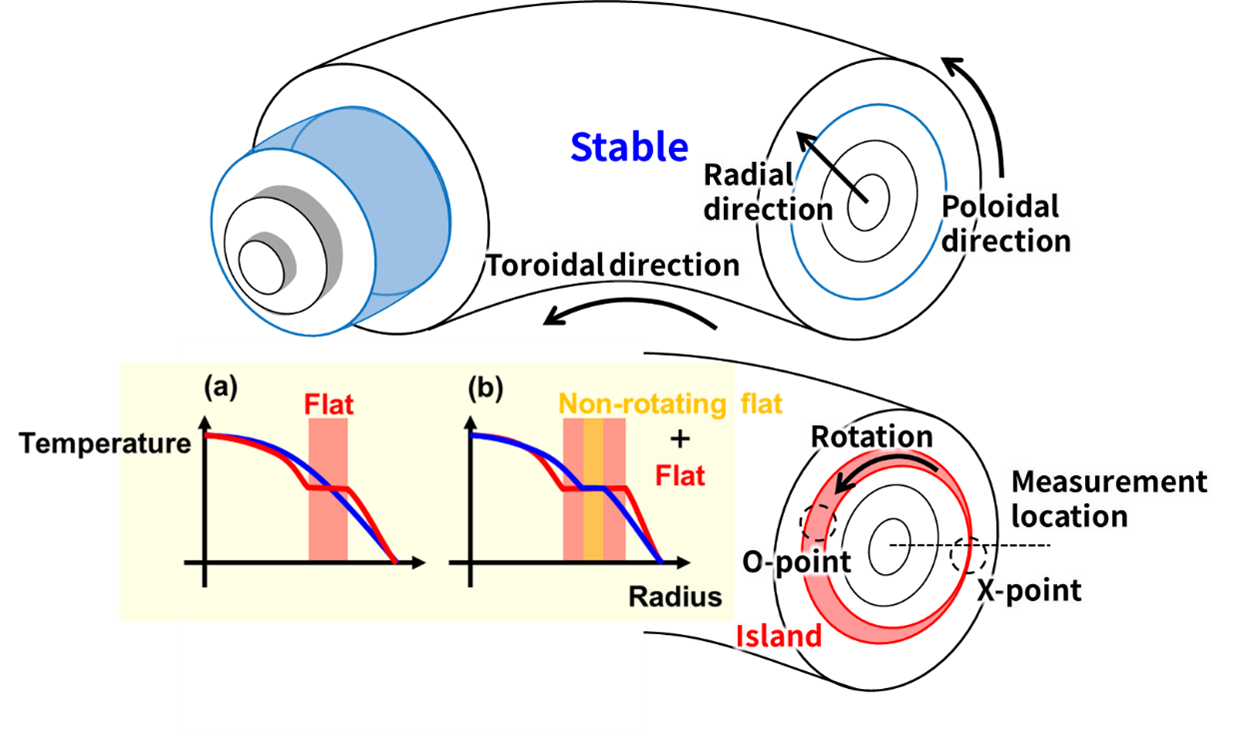First observation of characteristic fine structure of global plasma fluctuations
In magnetic confinement plasmas, the rapid growth of temperature fluctuations after the rotation of its fluctuation stops is a problem, and a new measurement technique at LHD has successfully measured the fine structure of temperature fluctuations during the slowing-down of the rotation. We found for the first time that the radial profile of the temperature around the location of the fluctuation changes with time, either flattening or tilting, and that some of the region are constantly flattens. This result will contribute to the understanding of the above fluctuations and will advance the study of other fluctuations using this measurement method.

In magnetic confinement plasmas, the rapid growth of temperature fluctuations after their rotation stops is a problem, and a new measurement technique at the LHD has successfully measured the fine structure of temperature fluctuations during the slowing-down of the rotation. We found for the first time that the radial profile of the temperature around the location of the fluctuation changes with time, either flattening or tilting, and that some of the region constantly flattens. This result will contribute to the understanding of the above fluctuations and will advance the study of other fluctuations, using this measurement method.
Fluctuations in temperature, density and magnetic field are observed in magnetic confinement plasmas. The fluctuations rotate with the plasma and can grow rapidly after the rotation slows down. The growth of the fluctuations is a problem in magnetic confinement plasmas because they can seriously degrade the plasma confinement performance.
Since the growth of the fluctuations (locked-mode-like instability) is also observed in the LHD, the characteristics of the fluctuations before the growth has been investigated. Their spatial structure is an important parameter to characterize them. The radial structure of the local temperature is measured by a diagnostic called electron cyclotron emission measurement. However, due to the wide spacing of the measurement channels, this technique can only provide a global structure and cannot discuss the fine structure.
The LHD has the Thomson scattering system, a diagnostic with a narrow channel spacing, but the time interval is too long (33 Hz) to measure the slowing fluctuations (several hundred Hz). Recently, through a collaboration between the University of Wisconsin–Madison and the National Institute for Fusion Science, it has become possible to operate the Thomson scattering measurements with a shorter time interval (1 kHz) (fast Thomson scattering system).
By using the fast Thomson scattering system, we investigated the change of the temperature profile due to the fluctuations during deceleration. In the early stage of the deceleration, the red and blue temperature profile in Figure (a) appears alternately with time. This change in the profile can be interpreted as the rotation of a characteristic magnetic field structure localized at a specific radial place, called a magnetic island (see figure). When the magnetic island is formed, a flattening of the temperature profile occurs in the region called the O-point of the magnetic island, while the X-point has a small effect on the temperature profile.
If the magnetic island is rotating, the O- and X-points of the magnetic island appear alternately at the fixed measurement position, resulting in a change in the profile, as shown in the measurement results. On the other hand, at the end of the deceleration, in addition to the rotating magnetic islands, a region of constant flattening was observed (Fig. b yellow). Since the non-rotating flattened structure is narrower than the rotating magnetic island structure, the former has not been measured before by conventional methods (when the latter is widely spread, its structure has been observed by conventional methods). The application of a new measurement technique, the fast Thomson scattering system with high spatial and time resolution, to the measurement of the fluctuations has led to new discoveries.
It is suggested that these results are important for unravelling the deceleration mechanisms related to the growth of fluctuations. Based on these findings, the application of the fast Thomson scattering system to other types of fluctuations observed at the LHD is expected to lead to new discoveries.
This research result was published on August 2, 2021 in Plasma and Fusion Research, an online journal by the Japan Society of Plasma Science and Nuclear Fusion Research.
Publication
- Y. Takemura et al., "Mode Structure of Locked-Mode-Like Instability in LHD and Its Effects on Confinement Degradation", Plasma and Fusion Research 16 (2021) 1402091. [NIFS Repository]
Glossary
*Locked-mode-like instability: For more information, please visit “Slowing-down mechanism of rotating fluctuation in magnetic confinement plasmas”.
